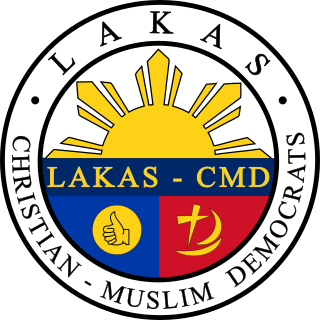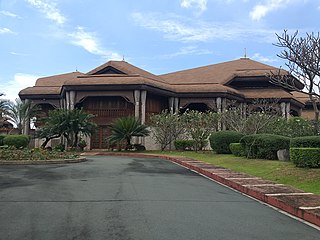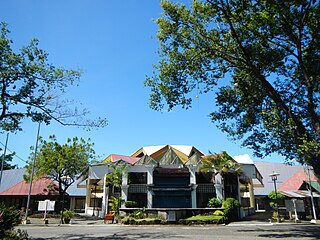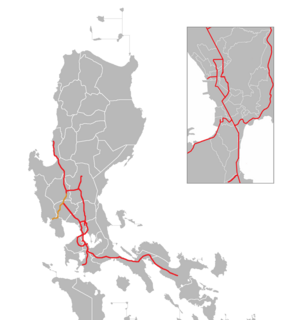
Fidel Valdez Ramos, popularly known as FVR and Eddie Ramos, is a retired Filipino general and politician who served as the 12th president of the Philippines from 1992 to 1998. He is the only career military officer who reached the rank of five-star general/admiral de jure who rose from second lieutenant up to commander-in-chief of the armed forces. During his six years in office, Ramos was widely credited and admired by many for revitalizing and renewing international confidence in the Philippine economy. At age 94, he is currently the oldest living former Philippine president.

Lakas–Christian Muslim Democrats (transl. People Power–Christian Muslim Democrats, abbreviated as Lakas–CMD and popularly known as Lakas, was a political party in the Philippines. Its ideology and that of its successor is heavily influenced by Christian and Islamic democracy. The party's influence on Philippine society is very strong, especially after the People Power Revolution, which has led the country to elect two presidents from the party, namely Fidel V. Ramos, a United Methodist, and Gloria Macapagal Arroyo, a Roman Catholic.

Angeles City, officially known as the City of Angeles, is a 1st class highly urbanized city in the Central Luzon region of the Philippines. According to the 2020 census, it has a population of 462,928 people.

The Coconut Palace, also known as Tahanang Pilipino, is a government building located in the Cultural Center of the Philippines Complex in Manila, Philippines. It was the official residence and the principal workplace of the vice president of the Philippines during the term of Jejomar Binay.

Clark International Airport, known as Diosdado Macapagal International Airport from 2003 to 2012, is an international airport covering portions of the cities of Angeles and Mabalacat within the Clark Freeport Zone in the province of Pampanga, Philippines. It is located 43.2 nautical miles northwest of Manila. It is accessible through the Subic–Clark–Tarlac Expressway (SCTEX).

The Paskuhan Village, officially known as the Philippine Christmas Village also known as Hilaga, is a Christmas-themed park located in San Fernando, Pampanga, Philippines. It is operational all year-round and is under the management of the Tourism Infrastructure and Enterprise Zone Authority.

The Department of Tourism is the executive department of the Philippine government responsible for the regulation of the Philippine tourism industry and the promotion of the Philippines as a tourist destination.

The Subic–Clark–Tarlac Expressway (SCTEX), signed as E1 and E4 of the Philippine expressway network and R-8 of the Metro Manila arterial road network, is controlled-access toll expressway in the Central Luzon region of the Philippines. From its northern terminus in Tarlac City to its southern terminus at Tipo in Hermosa, Bataan, the SCTEX serves as one of the main expressways in Luzon. The expressway is also connected to the Central Luzon Link Expressway, North Luzon Expressway, Tarlac–Pangasinan–La Union Expressway, and the Subic Freeport Expressway. The SCTEX is the country's longest expressway at 93.77 kilometers (58.27 mi). The Subic–Clark–Tarlac Expressway was constructed to provide a more efficient transport corridor between Subic Bay Freeport, Clark, and the Central Techno Park in Tarlac, foster development on the municipalities served, and connect major infrastructures such as the Subic Seaport and the Clark International Airport.

The Philippine Centennial was a series of celebrations by the Philippine government to primarily commemorate the 100th anniversary of the proclamation of Philippine Independence on June 12, 1898.

The Clark Freeport and Special Economic Zone (CFEZ), often shortened to Clark, refers to an area in Central Luzon, Philippines.

The presidency of Fidel V. Ramos, also known as the Ramos administration spanned for six years from June 30, 1992, to June 30, 1998. At the time of his assumption into power, Fidel Ramos was the third oldest person to become president of the Philippines at the age of 64. He is also the first Protestant president of the country and the only Filipino officer in history to have held every one hundred rank in the Philippine military from second lieutenant to commander-in-chief. the first few years of his administration (1992–1995) were characterized by economic boom, technological development, political stability and efficient delivery of basic needs to the people. During his time, he advocated party platforms as outline and agenda for governance. He was the first Christian Democrat to be elected in the country, being the founder of Lakas-CMD. He was one of the most influential leaders and the unofficial spokesman of liberal democracy in Asia.

Entertainment City, also known as E-City, is a gaming and entertainment complex under development by PAGCOR spanning an area of 8 km2 (3.1 sq mi) in Bay City, Metro Manila, Philippines. It was first envisioned by PAGCOR in 2002. Alongside the Aseana City business development, it lies at the western side of Roxas Boulevard and south of SM Central Business Park, part of Parañaque.

Mexico and the Philippines share a part of history dating from when the Philippines were under the administrative rule of the Viceroyalty of New Spain, modern Mexico, for the Spanish crown. Both nations are members of the Asia-Pacific Economic Cooperation, Association of Academies of the Spanish Language and the United Nations.

The Centennial Tower, also known as Luneta Tower, was a proposed mixed-use observation tower initially proposed to be located in Rizal Park, Manila, Philippines. It was later proposed to be built in Pasig amidst backlash over the original planned site. It was planned to be a memorial to the 100th anniversary of Philippine Independence.
In the Philippines, a government-owned and controlled corporation (GOCC), sometimes with an "and/or", is a state-owned enterprise that conducts both commercial and non-commercial activity. Examples of the latter would be the Government Service Insurance System (GSIS), a social security system for government employees. There are over 200 GOCCs as of 2020. GOCCs both receive subsidies and pay dividends to the national government.

New Clark City is a planned community currently undergoing development, located within the Clark Special Economic Zone in the towns of Bamban and Capas in Tarlac province, Philippines. It has an area of approximately 9,450 hectares and will accommodate up to 1.2 million people. It is owned and managed by the Bases Conversion and Development Authority (BCDA).
The Old Nayong Pilipino, officially the Nayong Pilipino Cultural Park, was a cultural theme park near the Ninoy Aquino International Airport in Pasay, Metro Manila.
The Ang Nayong Pilipino Foundation Inc. (NPFI), simply known as the Nayong Pilipino Foundation (NPF) or Nayong Pilipino is a non-profit organization based in Manila, Philippines.

The Nayong Pilipino Clark is a cultural park featuring themed areas of Filipino culture at the Clark Freeport Zone in Mabalacat, Pampanga.
The Nayong Pilipino Cultural Park and Creative Hub is a planned cultural theme park to be built at the Entertainment City in Parañaque, Metro Manila, Philippines.














